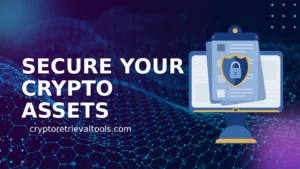Table of Contents
ToggleHow to Restore Your Wallet.dat File: A Step-by-Step Guide
Losing access to your cryptocurrency holdings can be a heart-stopping moment—especially if your only copy of the wallet.dat file has gone missing or become corrupted. In this detailed blog post, How to Restore Your Wallet.dat File will walk you through every critical step of the recovery process, explain advanced DIY techniques, and show you when it’s time to call in the pros. Plus, we’ll cover how crypto recovery experts can provide help in recovering your wallet.dat file when standard methods fall short.
Why You Need to Know How to Restore Your Wallet.dat File
Your wallet.dat file is the cryptographic keyring to your Bitcoin or altcoin fortune. It contains:
-
Private keys: The secret codes that authorize spending.
-
Address metadata: Labels, contacts, and transaction notes.
-
Keypool entries: Unused addresses pre-generated for future transactions.
-
Encryption headers: If you protected your wallet with a passphrase.
Without a healthy copy of wallet.dat, your coins are effectively locked in a vault you can no longer open. Knowing How to Restore Your Wallet.dat File means safeguarding your digital assets against:
-
Accidental deletion
-
Hardware failures
-
Software bugs or upgrades
-
Malware or ransomware attacks
Pre-Restoration Checklist: Prepare Exactly Like a Pro
Before diving into file swaps and command-line flags, make sure you’ve ticked off these preparatory steps:
-
Create a Disk Clone
-
Use tools like
ddrescueon Linux or FTK Imager on Windows. -
Always work on the clone—not the original drive—to prevent further damage.
-
-
Gather Passwords & Seeds
-
Write down every passphrase variant you might have used.
-
If you generated a BIP39 mnemonic seed, keep that seed phrase close at hand.
-
-
Match the Software Version
-
Install the exact same wallet software release (e.g., Bitcoin Core 0.21) that first created your
wallet.dat. -
Mixing versions can sometimes introduce compatibility issues.
-
-
Free Up Enough Space
-
Plan for 500–600 GB free disk space if you need a full blockchain resync.
-
-
Set Up an Air-Gapped Environment (Optional)
-
If you’re security-conscious, use an offline machine with no Internet connection.
-
Step-by-Step: How to Restore Your Wallet.dat File
Follow these concrete steps to swap in your backup and bring your wallet back to life.
1. Locate Your Backup
Default backup locations by operating system:
-
Windows:
C:\Users\<YourUser>\AppData\Roaming\Bitcoin\wallets\wallet.dat -
macOS:
/Users/<YourUser>/Library/Application Support/Bitcoin/wallets/wallet.dat -
Linux:
/home/<YourUser>/.bitcoin/wallets/wallet.dat
Pro Tip: If you maintain multiple dated backups, choose the most recent one with a timestamp in its filename.
2. Shut Down Your Wallet Client
-
GUI Users: Close Bitcoin Core or your chosen wallet application completely.
-
CLI Users:
bashbitcoin-cli stop
Ensure no wallet processes (e.g., bitcoind, bitcoin-qt) are still running in Task Manager or via ps aux.
3. Swap in Your Backup File
-
Rename the corrupt file for safekeeping:
bashmv wallet.dat wallet.dat.corrupt -
Copy your backup into the
walletsdirectory:bashcp /path/to/backup/wallet.dat . -
Verify permissions match:
bashchmod 600 wallet.dat
chown $USER:$USER wallet.dat
4. Restart and Rescan
-
GUI Prompt: When you launch Bitcoin Core, it may ask to “Reindex” or “Rescan.” Approve it.
-
CLI Command:
bashbitcoind -rescan -datadir=/home/<YourUser>/.bitcoin-
For a deeper fix, you can run:
bashbitcoind -reindex
-
A rescan rebuilds your transaction history; a reindex rebuilds the entire blockchain database.
5. Unlock Encrypted Wallet (If Applicable)
If your wallet.dat is encrypted, unlock it with:
bitcoin-cli walletpassphrase "Your$ecureP@ssphrase" 3600
This unlocks it for 1 hour (3600 seconds). Adjust the timer as you work.
6. Confirm Restoration Success
-
Balance Check:
bashbitcoin-cli getbalance -
Transaction Audit:
bashbitcoin-cli listtransactions "*" 200
Compare your recovered balance and recent transactions against known records (exchange withdrawals, cold storage transfers, etc.).
Troubleshooting: Nail Every Common Error
| Error Message | Cause | Quick Fix |
|---|---|---|
| “Invalid or corrupt database” | Berkeley DB header mismatch | Downgrade to original wallet version, then open. |
| “Rescan never completes” | Out-of-sync block index | Delete blocks/ + chainstate/, then -reindex. |
| “Wallet encryption failed” | Wrong passphrase or deeper corruption | Try permutations; use pywallet key dump. |
| “Segmentation fault on launch” | Binary mismatch or RAM errors | Re-install wallet binary; test your RAM sticks. |
If you continue to hit blockers at this stage, it may be time to explore advanced methods—or wave the white flag and call in professional help.
DIY Advanced Recovery Techniques
-
pywalletPrivate Key Extractionbashpython pywallet.py --dumpwallet --datadir=/path/to/badwallet-
Outputs a new text file with all private keys.
-
-
Disk-Carving with PhotoRec
-
Point PhotoRec to your disk image; set it to look for “.dat” file signatures.
-
-
GPU-Accelerated Brute-Force
bashhashcat -m 11300 wallet.hash wordlist.txt --force-
Tackle wallet encryption headers with custom wordlists on powerful GPUs.
-
-
Manual Hex-Editor Patching
-
Compare a healthy
wallet.datheader/footer to your corrupt file and patch missing bytes.
-
Caution: Always work on clones. One false move can burn your last remaining copy.
 How Crypto Recovery Experts Can Provide Help
How Crypto Recovery Experts Can Provide Help
When DIY methods stall or the situation turns dire, crypto recovery experts have specialized tools and deep experience to rescue your funds:
-
Forensic Disk Imaging
-
Lab-grade, write-blocked imaging to prevent further data loss.
-
-
Chip-Off & Microsoldering
-
Physically remove and read flash memory chips for data on a microscopic level.
-
-
Custom Key Extraction
-
Bespoke scripts and reverse-engineering for proprietary wallet formats.
-
-
Password Recovery Suites
-
Large GPU arrays, distributed cracking nodes, and advanced social engineering for passphrase reconstruction.
-
-
Confidential, Documented Chain-of-Custody
-
NDAs, secure transport, and HIPAA-level data handling to keep your private keys safe.
-
When to Call the Pros:
Your drive won’t mount.
You’ve lost all backups but know coins are still on-chain.
DIY carving and cracking have failed after exhaustive effort.
Fortify Your Future: Backup Best Practices
-
3-2-1 Backup Rule
-
Three copies, two different media, one offsite (e.g., cloud or safety deposit box).
-
-
Mnemonic Seed Adoption
-
Use BIP39/BIP44–compatible wallets so you can restore without
wallet.dat.
-
-
-
Keep large balances on hardware wallets or 2-of-3 multisig setups across trusted parties.
-
-
Automated Incremental Snapshots
-
Tools like
rsnapshotor Duplicati to capture hourly changes.
-
-
Quarterly Restore Drills
-
Simulate a full recovery on a secondary machine to ensure your backups actually work.
-
Conclusion
Knowing How to Restore Your Wallet.dat File is essential for every serious crypto holder. From careful preparation and hands-on file swaps to hyper-advanced DIY techniques and the unmatched capabilities of crypto recovery experts, you now have a complete roadmap to reclaim your funds. Don’t wait for disaster to strike—backup today, practice your restores, and keep the experts’ contact info on standby!
For further assistance Contact us

 China
China Russia
Russia India
India









